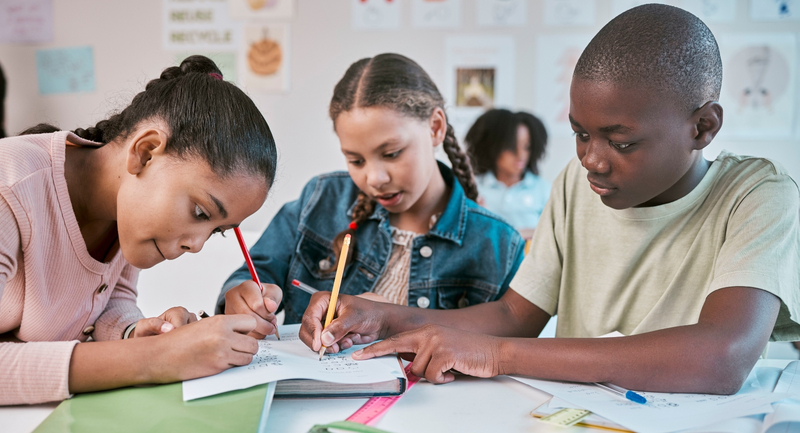While planning for the 2018–2019 school year, my co-counselor and I noticed some troubling data at Five Forks Middle School in Lawrenceville, Georgia. We found that students of color were being disciplined at disproportionate rates. Specifically, while Black and Latino males made up 23 percent of our overall student population, they received 61 percent of all discipline referrals. With these referrals came educator-initiated consequences, such as in- and out- of school suspensions that disconnected students from their classroom learning, their peers, and teacher support. Beyond the academic and social implications, students also experienced the natural consequences of feeling othered, misunderstood, and like they don’t belong. We know from research that zero-tolerance policies and punitive discipline consequences like suspensions can contribute to a negative self-image, decreased emotional wellness, and a loss of trust in the school.
Unfortunately, such racial disparities are not limited to our one school. Black and Latinx young people face disproportionately harsh discipline in schools across the country, which only serves to deepen existing racial inequities in the education system.
This was not the culture of empathy and healing we wanted to provide for our students at Five Forks. So, we decided to confront this problem head-on, and by the end of the following school year, discipline referrals for Black and Latino male students decreased by 32 percent.
How did we promote healing and connection over punishment to achieve more equitable outcomes?
SEL to Pave the Way
As we dug into our problem, we realized that the racial disparities in our discipline data were nothing new. For several years, our counseling team had been working directly with the students receiving discipline referrals—both in small groups and individually—through an asset-based approach. However, this disturbing trend continued.
To make meaningful change, we had to first recognize the truth: Students of color who suffer the consequences of inequities are not the problem. Educational equity was, and is, an adult issue. As educators, we create the school environment through policies, practices, and our daily interactions with our students.
To build educational equity, we had to shift our focus from students to staff. That meant coming together as a whole staff so we could openly discuss the problem of racial discrepancies in our discipline referrals and offer training to help change the learning environment. We used social and emotional learning (SEL) to support the whole child, strengthen our staff competencies, and improve the environments that surround our students. The CASEL framework guided our journey.
We started by reviewing adult SEL competencies, including an examination of our personal and cultural identities, as well as our learned prejudices and implicit biases that might sneak into our day-to-day interactions with students. Our student population is more racially diverse than our staff, so we looked to strengthen our own self-awareness first, then social awareness, relationship skills, and responsible decision-making.
Our implicit bias training included the “I Am… But I Am Not” activity and “The Mindful Reflection Protocol: A Process for Checking Unconscious Bias.” We also routinely shared emails with helpful strategies and offered a book study on Zaretta Hammond’s Culturally Responsive Teaching and the Brain. Participating staff members built an understanding of what it looks like when a student doesn’t feel safe in the classroom, and how that can affect their learning. This awareness-building was critical to interrupting potential harm and supporting equity in the classroom.
To make the trainings successful, we focused on creating brave spaces in all-staff development and in small group book studies; we established group agreements, gave one another grace to grow and learn, and defined common terms so everyone would have the same foundation for discussion. I made a point, as well, to be vulnerable and share examples of my own implicit bias to allow others to feel more comfortable doing the same.
Transcending “Basic Kindness”
We also applied SEL in the larger context of our relationships with colleagues, students, their families, and the school community. We used modeling as a tool to teach new strategies and support those relationships. For example, I felt it was important to show how we might mend potential breaks when a disciplinary action is taken. My co-counselor and I modeled going back to the student with empathy and compassion, ensuring they understand that a misstep does not define who they are, and encouraging growth of all those involved— including the adult.
To help repair disconnections, we used the “Speak Up Against Bias” guide from Learning for Justice. We shared with faculty and staff strategies to interrupt bias, discrimination, and stereotypes. Our faculty then led discussions for students using Learning for Justice’s “Speak Up at School Pocket Guide” to teach students that they have the power to speak up by interrupting, questioning, educating, and echoing. In addition, we led discussion on how to interrupt the cycle of inequity by intentionally participating in micro-affirmations (as noted in the National Alliance for Partnerships in Equity’s Ensuring Equity in Problem-Based Learning Toolkit).
Our work to improve discipline outcomes also demanded that anti-bias and anti-racist staff development was a continuous priority. As school counselors, we love talking about kindness. But we knew our work with students had to go beyond just basic kindness. When using the CASEL framework, we emphasized real-world situations our students could identify with to help make anti-racist SEL the norm. This commitment includes always addressing racism when it happens.
For example, if a stereotype or a racial slur is used between peers, it is insufficient to say, “We all need to be kind to one another.” We have to name the bias in order to maintain healthy relationships and make constructive choices about personal behavior. Then, we need to educate on why the biased or racist language is wrong, examine how it impacts others, and talk about what should happen next. If we shift the culture of our schools to transcend basic kindness and reach toward anti-bias and anti-racist SEL, we can put equity into action for our students.
The Work That Remains
As inspirational speaker Alexander Den Heijer has shared on his Twitter and Tumblr accounts, “When a flower doesn’t bloom, you fix the environment in which it grows, not the flower.”
At my school, our collaborative SEL efforts to challenge inequity and promote healing successfully reduced racial disparities in discipline. But much more work remains (at our school and at every level of our education system) to make schools centers of healing for all students. When I lead difficult conversations at my school or with other school counselors, I emphasize that this work is about all of us, including myself. Anti-bias, anti-racist SEL is active and ongoing. It does not end. As we work to do better, we must remember that our continuous learning is to ensure all students attend a school where they experience belonging, healing, and success.








